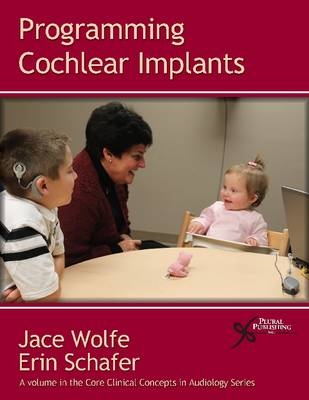
Programming Cochlear Implants
Plural Publishing Inc (Verlag)
978-1-59756-372-7 (ISBN)
- Titel ist leider vergriffen;
keine Neuauflage - Artikel merken
Cochlear implants offer substantial benefit for children and adults with severe to profound hearing loss. However, for recipients to realize their full potential with the device, it must be carefully programmed. Programming Cochlear Implants, a volume in the Core Clinical Concepts in Audiology Series, offers practical guidance for clinicians who program or plan to program cochlear implants, introducing the basics of cochlear implant programming and continuing through advanced programming techniques. Manufacturer-specific information is provided, and case studies are presented to illustrate cochlear implant programming fundamentals and strategies. Specific topics covered include: basics of cochlear implant terminology and programming, clinical protocols for cochlear implant management, programming considerations for bilateral cochlear implant recipients, troubleshooting during the programming process, device-specific programming techniques, basic use of objective measures to set cochlear implant programs, use of FM and assistive listening devices with cochlear implants, and management of the difficult-to-program recipient.
This book serves as a practical guide for clinicians who are providing services to cochlear implant users and also as a teaching tool for graduate-level students. Programming Cochlear Implants: Interview with Jace Wolfe, PhD Douglas L. Beck, AuD, speaks with Dr. Wolfe about his co-authored book, Programming Cochlear Implants, FM and Bluetooth, binaural hearing, bilateral cochlear implants, adult and pediatric criteria, and more.
Jace Wolfe, PhD Jace Wolfe, Ph.D., is the Director of Audiology at the Hearts for Hearing Foundation. He also is an adjunct Assistant Professor in the Audiology Department at the University of Oklahoma Health Sciences Center. Erin Schafer, PhD Erin C. Schafer, Ph.D. is an Assistant Professor in the Department of Speech and Hearing Sciences at the University of North Texas, where she has held an academic appointment since August 2005. She teaches graduate courses in the areas of aural rehabilitation, pediatric habilitation, diagnostic audiology, and research methods, and she serves as an Educational Audiology consultant for local school districts.
Chapter 1. Basic Components and Operation of a Cochlear Implant Basic Operation of Cochlear Implants Basic Components of Current Cochlear Implant Systems Advanced Bionics Corporation Sound Processor Internal Device Cochlear Corporation Sound Processor Internal Device MED-EL Corporation Sound Processor Internal Device Key Concepts of Chapter 1 Chapter 2. Basic Terminology of Cochlear Implant Programming Parameters Affecting Signal Coding in the Intensity Domain Stimulation Levels Threshold of Stimulation Upper Stimulation Levels Current Amplitude and Pulse Width Mapping Acoustical Inputs into the Electrical Dynamic Range Input Dynamic Range (IDR) Sensitivity Compression Channel Gain Volume Control Setting Parameters Affecting Signal Coding in the Frequency Domain Electrode Contact vs. Channel Virtual Electrodes (Current Steering) Frequency Allocation Parameters Affecting Signal Coding in the Time Domain Stimulation Rate Basic Cochlear Implant Terminology Electrode Coupling Strategy/Stimulation Mode Sequential vs. Simultaneous Stimulation Interpolation Sweeping Loudness Balancing Radio Frequency (RF) Telemetry Electrode Impedance Voltage Compliance Mixing Ratio Basic Cochlear Implant Signal Coding Strategies Continuous Interleaved Sampling (CIS) HiResolution Sound Processing n-of-m Strategies Spectral Peak (SPEAK) Advanced Combination Encoder (ACE) MP3000 Fine Structure Processing (FSP) Simultaneous Analog Stimulation (SAS) Key Concepts of Chapter 2 Chapter 3. Basic Principles of Programming Pre-Activation Procedures Realistic Expectations Prior to Activation Reviewing Logistics of Cochlear Implantation Familiarity with Cochlear Implant Hardware Setting the Stage Programming After Implantation Physical Evaluation Selecting a Signal Coding Strategy Streamlined vs. Comprehensive Programming Measuring Stimulation Levels Setting Threshold Levels for Adults Setting Threshold Levels for Children Additional Measure to Ensure Adequate T Levels and Confirm Audibility Setting Upper Stimulation Levels for Adults Setting Upper Stimulation Levels for Children Additional Measures to Set Stimulation Levels Adjustments to Special Parameters Stimulation Rate Pulse Width Channel Gain Frequency Allocation Input Dynamic Range (IDR) Maxima Key Concepts of Chapter 3 Chapter 4. Manufacturer-Specific Programming Considerations Advanced Bionics Corporation HiResolution (HiRes) 90K System Electrode Impedance Selecting a Signal Coding Strategy Setting Stimulation Levels Additional Programming Parameters Input Processing Microphone Sensitivity and Volume Control Channel Gains Extended Filtering Input Dynamic Range (IDR) Audio-Mixing Ratio Lock Automatic Gain Control (AGC) Indifferent (Reference) Electrode Ground Channel Clipping Programming Previous Generations of Advanced Bionics Implants Cochlear Corporation The Nucleus 5 System Electrode Impedance Selecting a Signal Coding Strategy and Preprocessing Parameters Setting Stimulation Levels Additional Programming Parameters Microphone Sensitivity and Volume Control T-SPL, C-SPL, and the IIDR Autosensitivity Breakpoint Loudness Growth Jitter Telecoil-Mixing Ratio Accessory-Mixing Ratio Channel Gains Voltage Compliance Prediction of Stimulation Levels from Other Programs Power Level SmartSound Preprocessing SmartSound Environment Personalization Indicators Automatic Telecoil Double Channel Mapping Channel-to-Electrode Assignment Bilateral Mapping Programming Previous Generations of Nucleus Implants MED-EL Corporation Programming MED-EL Recipients in Fine Structure Processing Electrode Impedance Selecting a Signal Coding Strategy Setting Stimulation Levels Additional Programming Parameters Frequency Bands Maplaw Volume Mode Automatic Sound Management (ASM) Indicators Programming Previous Generations of MED-EL Implants Key Concepts of Chapter 4 Chapter 5. Clinical Considerations: Putting All of the Pieces Together Collaboration with the Cochlear Implant Surgeon/Medical Evaluation Programming Schedule Two-day Initial Activation Sessions One-Week Post-Activation Appointment One-Month, Post-Activation Programming Session Remainder of Programming Schedule The Role of Electrically-Evoked Potentials in Programming Additional Habilitative/Rehabilitative Considerations Considerations for Bilateral Cochlear Implantation Key Concepts of Chapter 5 Chapter 6. Troubleshooting Patient Complaints and Complications Managing Recipients Who Experience Disappointing Outcomes External Hardware Determine Wear Schedule and Facilitate an Auditory Lifestyle Evaluate the Appropriateness of the Cochlear Implant Program Assessment of Internal Hardware Identifying "Red Flags" Factors Influencing Cochlear Implant Outcomes Additional Disabilities Bacterial Meningitis Aplastic Auditory Nerves Inner Ear Malformations Pre-lingual Deafness and Duration of Deafness Prior to Implantation Advanced Age Internal Device Function Programming Adjustments for the Most Common Complaints and Complications Key Concepts of Chapter 6 Chapter 7. Hearing Assistance Technology (HAT) and Cochlear Implants Basic Description of Personal Systems Optimal Systems for Use with a Cochlear Implant Description and Programming for Personal HAT and Cochlear Implants FM Transmitters FM and Induction Loop Receivers Programming Considerations for FM Receivers and Sound Processors FM-Receiver Programming Sound Processor Programming and HAT Audio-Mixing Ratios Input Dynamic Range (IDR) Processor Sensitivity Fitting Procedures for Personal FM Systems Monitoring and Troubleshooting Personal FM Systems for Cochlear Implants HAT to Improve Telephone Conversations Telecoils Manufacturer-Specific Information Telecoil Accessories Summary of HAT for Cochlear Implants Key Concepts of Chapter 7
| Erscheint lt. Verlag | 30.4.2010 |
|---|---|
| Zusatzinfo | 2/C |
| Verlagsort | San Diego |
| Sprache | englisch |
| Maße | 216 x 279 mm |
| Themenwelt | Medizin / Pharmazie ► Medizinische Fachgebiete ► HNO-Heilkunde |
| ISBN-10 | 1-59756-372-2 / 1597563722 |
| ISBN-13 | 978-1-59756-372-7 / 9781597563727 |
| Zustand | Neuware |
| Haben Sie eine Frage zum Produkt? |
aus dem Bereich


